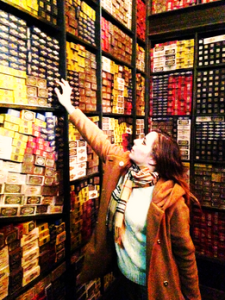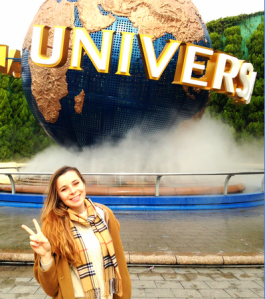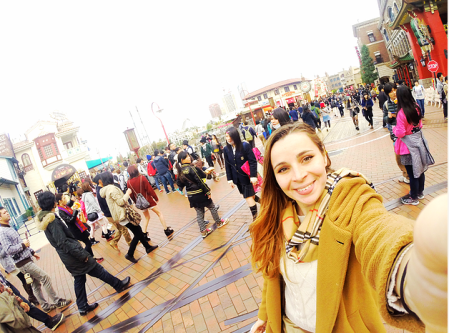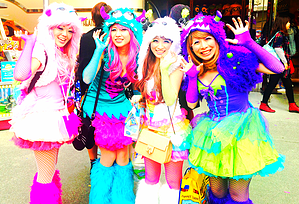In 2014 I made the big decision to get LASIK eye corrective surgery abroad, in Japan. This is MY experience and I hope it can be useful to other people out there. For more about my choices in getting LASIK read the bottom paragraph “Background”.

Pre-operation: I had an initial eye-check-up appointment where they measured my eye’s dimensions and told me if I was eligible and my surgery choices. I used this as a chance to check out their facilities, hygiene and overall credibility (it was similar to Australia). Then I didn’t use contacts for about two weeks before another eye appointment measuring my eyes without contact use on the same machines. At this appointment they gave me a briefing about the surgery (and other small lifestyle changes for before surgery eg. Eye drops). The following appointment was the actual surgery. Here’s a picture of my eyes before surgery:

Operation-day (17th August, 2014, 14:00): I arrived a little nervous and was given plenty of time to relax and settle, I had chosen to pay on the day of procedure, so I did that before they prepared me. They did a third eye-check to make sure everything was still the same and there was nothing floating in my eyes. They gave me some medication to relax my muscles (less likely to flinch in surgery, although the machine stops if you trigger its motion sensors anyway). I put a robe on over my clothes and wore a hair net, laid down on a reclined seat with machinery looking down at me from above in a dark room. I was on the chair for 7 minutes total which felt much shorter to me since my eyes were only held open mechanically for less than a minute at a time with extra eye drop lubrication. I had practiced the night before holding my eyes open and couldn’t even do 1 minute! It was much easier when then lubricated and held them open.

1st eye: suction (feels like a plunger) I saw black and this was the most unnerving moment of the procedure – although entirely painless – because I didn’t know if I was accidentally moving my eye. I couldn’t feel this, but the laser had cut a flap in my eye quite quickly. He asked me to blink after releasing the “plunger” pressure clamping my eye, asking if I had any pain which I didn’t. Same to 2nd eye.
The seat I was on swung to the right under another piece of machinery. This time my eyes were taped open and I was asked to stare at the light dot which was so easy and quick it was actually incredible! Before I was allowed to blink they used a light brush to put the flap back in place, I could see the brush but not feel it. They asked me to blink and told me I was finished. They took a quick eye check (Pre-procedure: Left -2.75, Right -2.75) Post procedure: L 1.5, R 2.0 ! Naturally eyes balance out in the coming 3 months. I didn’t wear eye patches leaving the surgery, just sunglasses. Here is a pic outdoors with me trying to keep my eyes open but feeling sensitive to light.

For 6.5 hrs after surgery my eyes were sensitive to light and my vision fluctuated choosing only to see short-sighted in focus or long-sighted.

6.5 hrs after surgery I had perfect vision and no pain, it was so clear. I took all eye drops and pain killers as I had been told to.
Day-after procedure: They had to clean my eyes and they measured me the same as the day before: L 1.5, R 2.0

1 week check-up: (Pre-procedure: Left -2.75, Right -2.75) Post-procedure: L 1.5, R 1.5
8 days after surgery I spent 5-6 hours on a computer without breaks and felt a headache and a hint of nausea so I stopped and took a Panadol, it was gone within the hour.
6 month check-up: No other discomfort. My only side effect from the surgery is light halo’s which I only notice when driving at night. This doesn’t impair my driving or lessen my quality of life. I am so grateful for the changes that LASIK has made in my life, here’s a picture of my eyes no, since the day of surgery I haven’t had any pain.

Reflection & Recommendation:
The most shocking part of the procedure was that it was virtually painless, the slight sting from eye drops before the surgery was the most pain from the whole thing. The most unnerving part was the pressure on my eye ball that caused black vision because I didn’t want to do anything wrong. I could not even feel the laser cutting. I could see lights and hear tazer-like sounds throughout the procedure but there was almost no sensation/pain. I recommend getting LASIK in Japan through Kobe Kanagawa Clinic, it is safe and trustworthy but Japanese ability could be advantageous at times. However, coming to Japan just for the surgery is not worth it in overall price.
How much did I save and was the risk worth it? This procedure costs AUD$6,000 in Australia and I got it done in Japan for AUD$2824. This risk was worth it for me, but you never know before the surgery. The procedures and benefits were the same in Australia and Japan. The biggest positive to getting it in Japan was price. The biggest negative was the slight language barrier that still existed when their translator wasn’t present.
If you get LASIK you are one brave person. And if you get it done abroad, you are one very brave person. I hope the results pay off for you all as they did for me. This is a really personal choice so I wish you the best in making.
Let me know what you think of LASIK below!
– Bec
Caution: After 3 minutes it is hard to watch this video:

*Background* I got glasses for short sightedness in high school and never really got used to them with my active lifestyle. I decided to use contact lenses which I used for about 6 years (this thinned my cornea but I could still get LASIK). In my final year of University in Australia I was old enough to get LASIK but when I looked into the prices it was totally unaffordable. I started natural eye exercises, but with my busy lifestyle I didn’t give it my all and didn’t see any positive results. I was planning on going to Japan anyway and looked up LASIK prices online on a whim and found only one website with some sections in English (via this helpful blog:
http://www.biginjapan.co/biginjapan/getting-lasik-in-japan/). Their price list was less than HALF of the Australian price. Kobe Kanagawa Eye Clinic is the name of the clinic I used. While most staff at the clinics did not speak English, Dr Masuda from their Tokyo branch was perfectly bi-lingual and English paperwork was helpful too. My operating doctor spoke some English. I was primarily worried my vision might be worse than naturally after operation. My emotions were probably amplified by the fact that I was far from home and had only ever had one surgery before. Making the decision to do LASIK was harder than I anticipated. I had my partner with me and couldn’t have done it without him, you should ensure you have support with you on the day of operation. I would recommend asking friends that have had LASIK for feedback, that’s what made me finally decide to take the plunge. Also the fact that 95% of people are satisfied with their vision after LASIK and there are no recorded cases when LASIK has definitely caused blindness. PS. DO NOT WATCH HORROR VIDEOS ON YOUTUBE (that’s torture).

















































 I’ve been studying Japanese for four months now and I had to work really hard for it. It has been incredibly difficult, complicated, sometimes it felt like forever studying. Learning Japanese is tough for a native English speaker, but I was motivated to learn it to improve my ease and independance living in Japan. After two months of studying I wrote a progress report about how the language barrier affected my life and how much Japanese I’d learnt in 8 weeks (
I’ve been studying Japanese for four months now and I had to work really hard for it. It has been incredibly difficult, complicated, sometimes it felt like forever studying. Learning Japanese is tough for a native English speaker, but I was motivated to learn it to improve my ease and independance living in Japan. After two months of studying I wrote a progress report about how the language barrier affected my life and how much Japanese I’d learnt in 8 weeks (







 ony of it all was really beautiful!
ony of it all was really beautiful!





